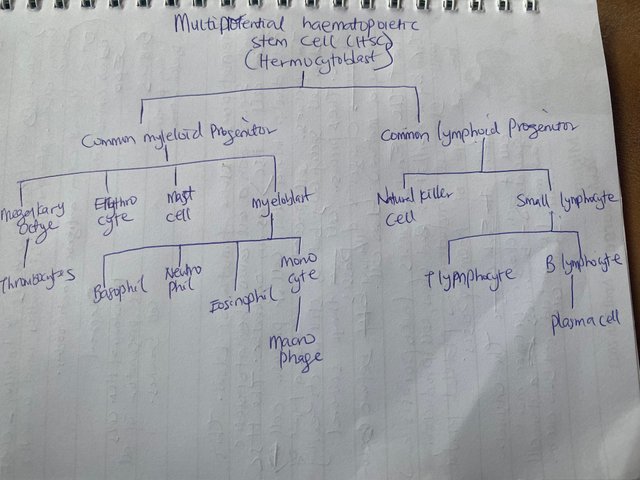SEC S20W1 || Hematopoiesis - Module 1
Greetings and welcome to my blog. Am glad to be a part of this week’s engagement challenge. Thank you @dexsyluz for this great lesson. I must say that for a non medical personnel like me, this lesson is an eye opener and I learnt a lot going through the teaching. I would try and answer the assignment as much as I understand.
Anatomy and function of hematopoietic organs |
|---|
Hematopoiesis is simply the process through which blood is formed. In humans, there are organs which enable the formation of blood right from when the egg is fertilized and till we grow into full adulthood and the organs in which blood is formed at different stages are called hematopoietic organs.
The blood is formed at different sites and these sites are called hematopoietic sites and the organs includes the yolk sac, spleen, liver, lymph nodes, the thymus and also the bone marrows. The different sites of formation varies with age of the fetus.
Blood formation in the yolk sac starts after 19 days of the egg fertilization in the womb and continues till about two months. This is followed by the liver. The liver is actually the main organ of blood formation through the pregnancy but start its work a month after fertilization and continues till the baby is born.
The spleen comes in to help towards the middle of the second month till the seventh month. The lymph nodes and the thymus also join in blood production even though not as much as the spleen does and they continue till we reach puberty stage.
The bone marrow comes into play which serves as the main site for blood formation as we mature even though it starts its work little by little at two months of the fetus but when we grow up at about twenty years of age, the blood formation main sites become the vertebrae, sternum, ribs and femur even though the femur stops at age 30.
Medullary Hematopoiesis vs. Extramedullary Hematopoiesis |
|---|
Medullary Hematopoiesis is the type of Hematopoiesis or blood formation that happens in the inner part or the medullar of the bone. This usually starts in the fifth month of fetal development, during myeloid phase where the mesenchymal cells and HSC’s migrates into bones.
Extramedullary Hematopoiesis is the formation of blood outside cells outside the bone marrow. Extramedullary Hematopoiesis occurs mostly when there are pathological conditions such as lymphoma, leukamia, myelofibrosis and etc.
Make a diagram of Hematopoiesis and explain it in your own words. |
|---|
From the diagram we see the originator cell known as the MHSC; the haemotopoietic stem cell which splits into two originator cells known as the Myeloid progenitor and the Lymphoid progenitor cells. The common myeloid progenitor cells produces the magakaryoctye, erythrocyte, mast cell and myeloblast. The megacaryocyte produces the thrombocytes (platelets).
The myoloblast produces which includes basophil, neutrophil, Eosinophil and manicyte which also produces macrophage which deals with dead cells and microscopic organisms.
The lymphoid progenitor produces natural killer cells, Small lymphocytes, T lymphocytes and B lymphocytes which also produces plasma cells. These plasma cells generate antibodies that fight harmful microorganisms in the body.
In your opinion, what are the reasons for the significant blood loss? |
|---|
There are a couple of reasons for the blood loss in the patient and some of them includes;
The patient has bruises all over his body and those are avenues for blood loss through the bruised cells and tissues
The X-ray showed a broken femur, being 25 years of age, the femur is the major site of blood production at this age hence the significant blood loss.
The patient was diagnosed of kidney problem too. With the kidney disease, his kidneys cannot produce enough EPO and low levels of EPO would cause a drop in his red blood cell count which will lead to Anaemia.
Who would be the ideal person to donate blood to? (profile of the ideal donor) |
|---|
In blood donation, the idea of compatibility comes in first. The ideal person that would be able to donate blood to the patient would be someone who has a compatible blood group with him and would have to undergo text samples to determine the blood is not infected.
The blood group O is a universal donor because it does not contain antigens and anti bodies hence it can donate blood to other blood groups.
I ask @ruthjoe, @ngozi996 and @jovita30 to join the challenge.




Para quienes no somos profesionales en el área de la salud, nos resulta un poco complicado entender estos temas, pero se nota que has investigado, lo que te ha permitido usar un lenguaje sencillo y explciar muy bien todo el proceso de formación de las céluldas sanguíneas.
Es increíver ver como diferentes órganos del cuerpo son responsable de la formación de la sangre, cada uno conforme a las etapas de crecimiento del ser humano.
Éxitos en su participación.